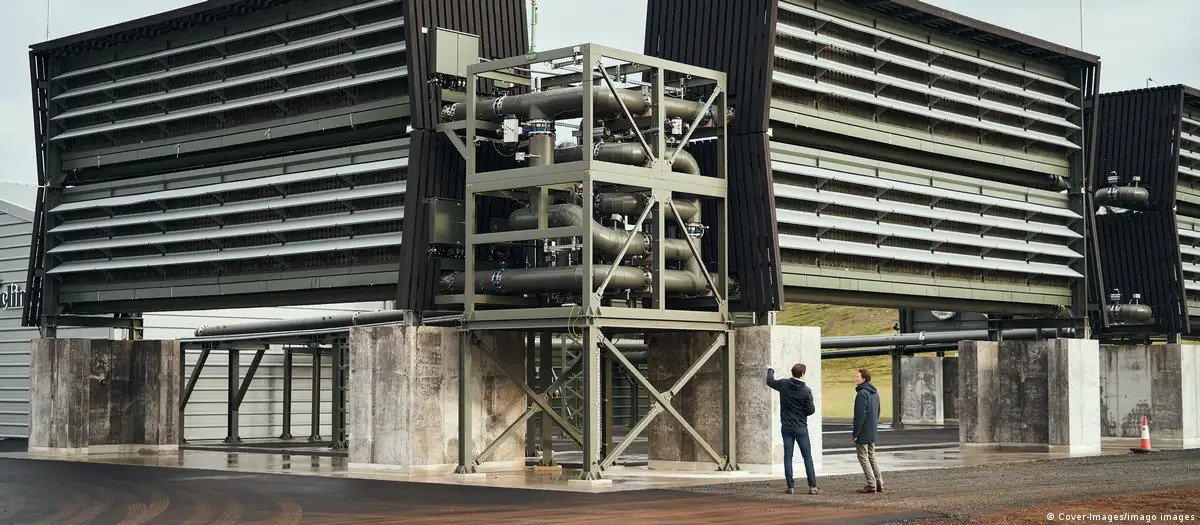In a bold move to fight the climate crisis, the United States has committed $1.2 billion to create two carbon-sucking vacuums that aim to capture carbon dioxide (CO2) directly from the atmosphere. These two massive Direct Air Capture (DAC) facilities, located in Texas and Louisiana, are designed to each remove up to one million tons of CO2 annually. This is equivalent to the emissions of 445,000 gas-powered cars each year, offering an innovative approach to tackling the growing global environmental crisis.
A Revolutionary Technology: Direct Air Capture
The technology behind these machines, Direct Air Capture (DAC), is one of the most advanced methods of addressing the climate emergency. These machines work by drawing in air and passing it through a chemical filter that captures CO2, leaving other gases behind. Once captured, the CO2 is stored underground or repurposed for industrial uses such as concrete production or aviation fuel.
The technology is still relatively untested at a large scale, with only a few DAC facilities operating globally, including a successful plant in Iceland, operated by the Swiss company Climeworks, a key partner in this project. Climeworks has already demonstrated the effectiveness of DAC in capturing carbon in smaller amounts, and now, with the US government’s support, the hope is to scale the technology to a level that could make a real dent in global emissions.


While each DAC facility may seem like a small contribution in the fight against climate change, the potential impact is significant. If scaled to the level required, DAC could play an essential role in meeting the world’s net-zero emissions goals.
The $1.2 Billion Gamble
The US Department of Energy’s investment will support two facilities in Texas and Louisiana, with each facility expected to capture one million tons of CO2 annually. According to Secretary Jennifer Granholm, “Cutting back on our carbon emissions alone won’t reverse the growing impacts of climate change,” adding that “We also need to remove the CO2 that we’ve already put in the atmosphere.” This reflects the understanding that reducing emissions is not enough on its own to address the scale of global warming.
The Louisiana project, dubbed Project Cypress, will be run by the US non-profit Battelle in partnership with Heirloom Carbon Technology and Climeworks. Shashank Samala, CEO of Heirloom, spoke optimistically about the pace of progress, stating, “Just two years ago, we were in a petri dish where we were removing grams of CO2 from the air… If we continue this pace of exponential growth every year, I think a billion tons a year is definitely, definitely achievable.”
Meanwhile, the Texas facility, led by Occidental and Carbon Engineering, is designed to scale up even further. Its ultimate capacity could reach up to 30 million tons of CO2 per year, making it a key part of the US’s long-term strategy to reduce atmospheric carbon.
The Challenges of Scaling Dac Technology
Despite the promising outlook, the Direct Air Capture technology faces significant hurdles. One of the primary concerns is the cost of operations, as the technology is still relatively expensive. Climeworks’ director Jan Wurzbacher noted that while the technology is advancing, it must become significantly cheaper in the coming years to have a meaningful impact on global CO2 levels. The challenge is not only financial but also technological, as scaling DAC to a level that can have a global effect requires further research and development.
Currently, the technology is considered “relatively untested” on a large scale, and costs are high. But the ambitious goals set by the US government signal a belief that DAC has the potential to change the way the world addresses the climate crisis. As Granholm emphasized, “If we deploy this at scale, this technology can help us make serious headway toward our net-zero emissions goals while we are still focused on deploying, deploying, deploying more clean energy at the same time.”
A Step Forward in the Climate Fight
While Direct Air Capture might not be the ultimate solution to the climate crisis, it represents an important tool in the fight to reverse the damage already done. The United Nations’ International Panel on Climate Change (IPCC) has identified carbon removal technologies like DAC as essential to keeping global warming within safe limits. In particular, the ability to capture carbon after it has already been emitted into the atmosphere may become crucial in stabilizing the climate over the coming decades.
Experts agree that scaling up DAC technology could provide substantial help in addressing emissions from sectors that are difficult to decarbonize. However, the cost and energy requirements for these machines remain a major concern. As Martin Penwald from Climeworks points out, “The energy used for these machines could be more effectively utilized directly on the grid,” raising the issue of whether the energy needed to power DAC systems could outweigh their benefits.
Yet the commitment to advancing this technology is a clear sign that the US is determined to address climate change through every possible avenue. If successful, this $1.2 billion investment could not only pave the way for more widespread use of DAC but also inspire other countries to invest in similar technologies.
Source link
